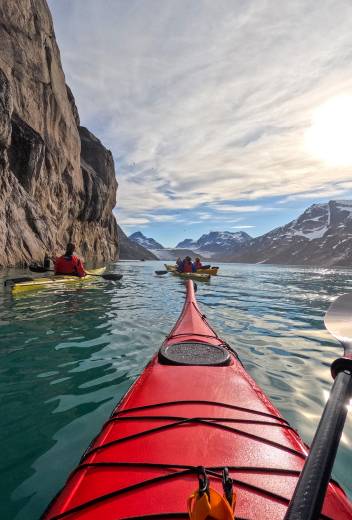Canada’s Remote Arctic Northwest Passage to Ellesmere and Axel Heiberg Islands
Starting from
- Calgary, Canada
Ships
- Ultramarine
Departures












Expedition Overview
Here, at the top of the world, you will be able to experience the planet in its most pure and natural state. You’ll witness a polar landscape preserved in all of its astonishing beauty—unsullied by human development, free of the blemishes of unfettered civilization. On this exciting itinerary, we follow the natural guides of sea and ice to showcase the region’s cultural, historic and geographic treasures, aiming to approach the farthest stretches of this rugged, rarely visited landscape. Our goals for this voyage are to visit Nunavut’s northernmost islands: Axel Heiberg, and Ellesmere. Our game changing expedition vessel Ultramarine’s unprecedented range of Adventure Options, including activities such as helicopter flightseeing, gives you an unrivaled polar experience. You’ll be able to view the magnificent wildlife that make their home in this forbidding region, including polar bears, whales, seals, walrus, caribou, and muskox. You’ll also learn about the rich Inuit culture that has persevered against all odds. From soaring cliffs to spectacular glacial formations, to stunning alpine vistas, expansive waterways to sheltered shores, Canada’s Remote Arctic provides the
definitive experience of a mysterious, magical region few ever get to see.
Our ship, Ultramarine, equipped with two twin-engine helicopters and 20 quick-launching Zodiacs, enables you to explore this breathtaking environment from brand new perspectives. You’ll experience the same sense of wonder felt by early explorers as they navigated the region’s formidable bays, inlets and channels.
Highlights
Search for iconic Arctic wildlife, such as polar bears, walrus and muskoxen
Learn about indigenous culture from Inuit guides onboard and ashore
Enjoy unforgettable flightseeing aboard Ultramarine’s two helicopters
Zodiac along the face of an active glacier
Channel your inner explorer as we set out to reach Canada’s most northerly islands: Axel Heiberg and Ellesmere Island
Find Your Ideal Itinerary
From Calgary, Canada, 12 days, on Ultramarine
- Duration
- 12 days
- Departing from
- Calgary, Canada
- Ship
-
Ultramarine
Learn more about the ship - Sold Out

Your Arctic expedition begins in Calgary. Explore this vibrant city on your own before you spend the night enjoying the comforts and amenities of your designated hotel.
This morning, board your charter flight to Resolute, Nunavut. Upon arrival, you may have a chance to check out this small hamlet on foot before being transferred to your ship via Zodiac or helicopter (depending on ship location and weather conditions).
Cruising around the remote islands of the Canadian High Arctic aboard Ultramarine, the newest ship in our fleet, you’ll navigate the same icy inlets, channels and bays that fascinated legendary explorers of long ago. Designed to give polar adventurers unprecedented access to the hardest- to-reach places on the planet—and equipped with two onboard twin- engine helicopters for unparalleled access to areas only Quark Expeditions can bring you—this one-of-a-kind ship will take you beyond the familiar in polar exploration. Throughout your journey, your Expedition Team will keep an eye toward immersing you in the best the Arctic has to offer, including reaching Canada’s most northerly islands: Axel Heiberg Island and the rarely visited Ellesmere Island, at the top of the world.
Remember that no two polar voyages are alike, since each expedition presents new opportunities and different weather and ice conditions. While this voyage has no fixed itinerary, our objective is to visit as many of the incredible highlights the season has to offer, using our extensive expertise to give you the best experience. Each day, your highly skilled Expedition Team will read the conditions and choose the best course to set, but despite their knowledge of these areas, each visit brings something new to discover. That said, our expeditions will have some elements in common, including daily Zodiac cruising, land excursions, a robust education program, a community visit and wildlife viewing opportunities. And thanks to our onboard helicopters, you’ll also discover the ultimate polar expedition experience: While polar landscapes are spectacular from the sea and on land, the view from the air is uniquely stunning. Conditions permitting, you’ll enjoy an ultra-immersive flightseeing activity (short sightseeing flights around your ship and surrounding areas) unique to Ultramarine, giving you an awe-inspiring polar experience like no other.
While this waterway is known to European cultures as the Northwest Passage, this area has nurtured and sustained the Inuit and their predecessors who have called these shores home for almost 5,000 years. Moving through these remote landscapes you will be traveling through the ancestral homelands of this ancient culture, illuminated in person by Inuit guides onboard and ashore. Nunavut is an Inuktitut word meaning “our land” and the Nunavummiut (the people of Nunavut) are renowned for their incredible resourcefulness, hospitality, good humor, and a deep knowledge of the land and animals that has allowed them to thrive in the far north for millennia.
Ultimately, your Expedition Team will keep its eye northward, hoping to follow in the footsteps of the lucky few polar adventurers who have transited through the famous Hell Gate to reach the top of the world, the spectacular Ellesmere Island. If conditions are right, the soaring, ominous snow-capped peaks of this polar desert will come into focus as we approach. The northernmost island in the Canadian Arctic Archipelago, Ellesmere is one of the most remote places on the planet, a land of deep fjords, jagged mountains and massive ice shelves. If we’re fortunate enough to reach here, you will be among the few polar explorers to do so. One of the goals of this expedition is to introduce guests to the unique glaciology of Axel Heiberg Island, Canada’s second-most northernly island, one-third of which is covered in glaciers. A glacier that spreads out as a wide lobe as it leaves a narrow mountain valley to enter a wider valley or a plain. Axel Heiberg is home to the most dramatic and impressive Piedmont glaciers in the world. The Piedmont glacier spreads out as a wide lobe as it makes it way out of a narrow mountain valley into a wider valley or a plain. Birders will want to have their binoculars and cameras at the ready, as the island also affords opportunities for sightings of snow buntings, ptarmigans, jaegers and arctic terns, among others.
Wildlife sightings are almost guaranteed, as many of the areas we hope to explore are home to a surprising number of birds and mammals that thrive in this challenging environment. You may see polar bears, muskoxen and several bird species, such as gyrfalcons and dovekies (little auks). If you’re lucky, you may even spot the elusive narwhal or arctic wolf, though sightings of these iconic creatures in the wild are rare, even in these areas where we have the highest chances of encountering them.
Coburg Island, for instance, is a wildlife reserve for such birds as snowy owls and peregrine falcons, while the impressive vertical cliffs of Prince Leopold Island are dotted with nesting seabirds like northern fulmars and black guillemots. The sheltered shores and steep cliffs of Arctic Bay, a hamlet located off of Admiralty Inlet, provide an ideal nesting habitat for various High Arctic birds such as snow geese, thick-billed murres (Brünnich’s guillemots) and kittiwakes. The region has been inhabited by Inuit and Thule cultures for almost 5,000 years. This community is an ideal spot to go ashore and learn more about the Inuit culture, sampling the local cuisine and mingling with artists, perhaps picking up carvings or other handicrafts as a memento of your polar adventure.
Devon Island is another possible locale for wildlife encounters, as walrus, polar bears and muskoxen inhabit the area, which is also the location of the remains of a Royal Canadian Mounted Police outpost, established at Dundas Harbour in 1924 to curb foreign whaling and other activities. Nearby is a small cemetery, one of Canada’s most northerly, still maintained by the RCMP to this day. Another exciting excursion your Expedition Team might offer, conditions permitting, is the opportunity to fly up to explore the Devon ice cap, one of the largest in the Canadian Arctic. History buffs will also be intrigued by the chance to visit an abandoned Hudson’s Bay Company trading post at Fort Ross, at the southern end of Somerset Island, and pay their respects to the ill-fated Franklin expedition of 1845–46 at the gravesite of three crew members on Beechey Island, one of Canada’s most significant Arctic exploration sites.
You may have the opportunity to cruise in a Zodiac along the face of an active glacier near Croker Bay and possibly even witness the wonders of calving ice, at a safe distance. Listen closely for the steady crackle and deep roars as slabs of ice break off and crash into the water below. You’ll also want to be on the lookout for the walrus that are often seen in the area.
There is no shortage of natural beauty, wildlife and history in Canada’s High Arctic. Each day, you’ll discover something new and inspiring, whether it is admiration of the tundra flora to survive the extremely rugged environment, a rare bird species soaring overhead, a polar bear on the hunt in its natural habitat, or the ancient remains of a Thule dwelling, predecessors of the Inuit who live here today.
After disembarking in Resolute, you’ll be transferred to your charter flight to Calgary, where you’ll spend the night at your included hotel.
Today, make your way to the airport to catch your homeward flights, or spend the day exploring this fascinating city.
Ultramarine
Ship Amenities
- Ready Rooms
- Polar Boutique
- Ambassador Theater
- Balena Restaurant
- Bridge
- Bistro 487
- Tundra Spa
- Tundra Sauna
- Fitness Center
- Panorama Lounge and Bar
Ship Features
- 40-day Operational Range
- Four Embarkation Points
- MAGS
- Twin Engine Helicopters (Excluding Svalbard and Spitsbergen Voyages)
- Water-level Zodiac Hangar
- Wraparound Deck

Ultramarine Deck

Ambassadors Theater

Ultramarine Balcony Suite (Double Bed)

Ultramarine Passengers

Ultramarine Library

Ultramarine Fitness Center

Ultramarine

Ultramarine Terrace Suite

Ultramarine – Panorama Lounge and Bar

Ultramarine's Ready Room

Ultramarine Spa

Ultramarine Sauan
Deck Plans & Cabins

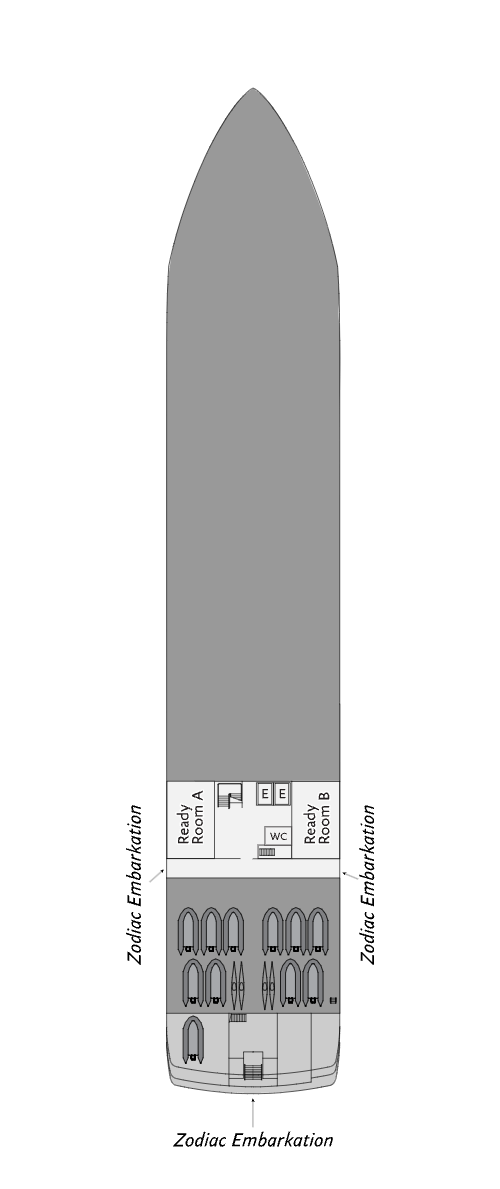
Ultramarine‘s off-ship adventures start here on Deck 2. This is where you’ll find the efficiently-designed Ready Rooms A and B next to the Zodiac hangar, where you’ll embark on your off-ship adventure options. Ultramarine’s two ready rooms include an individual locker for each guest to safely store and dry personal items and expedition gear between outings. They’re also equipped with benches that are handy when changing attire before or after off-ship excursions. Zodiac embarkation is at water-level which makes for quick deployment.
Public Spaces & Amenities

Ready Rooms
Designed for efficiency—with wider hallways, plenty of seating, and conveniently located bathrooms—our two ready rooms allow guests to quickly change in and out of their expedition gear.

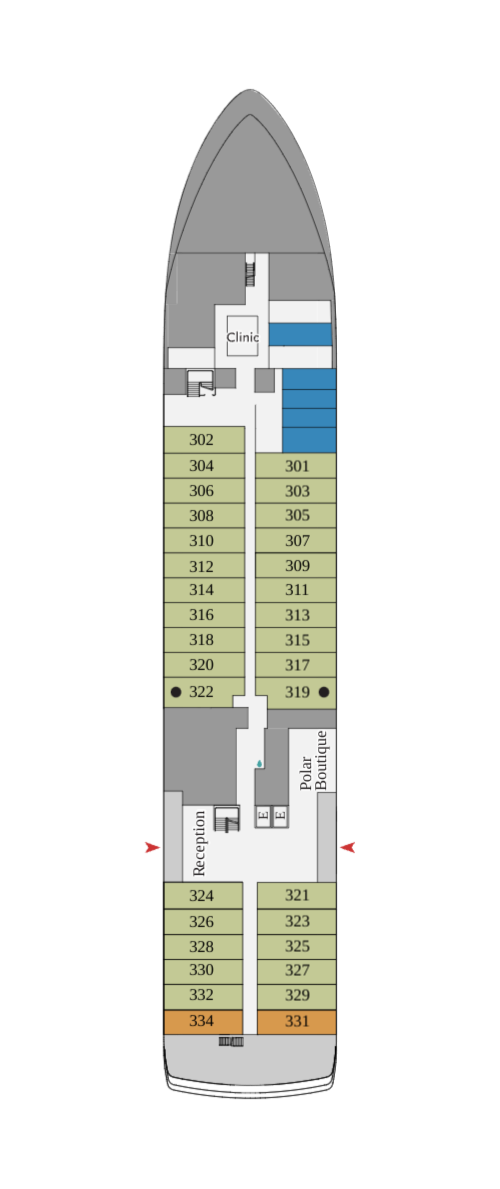
Deck 3 is where you’ll find Reception, where a crew member is available (during posted hours) to assist you. It’s also where you’ll purchase internet or email access cards and phone cards, arrange for a wake-up call, or settle your accounts at the end of the voyage. Also on Deck 3 is the Polar Boutique, which is stocked with expedition gear and a selection of polar souvenirs. The Clinic is located on Deck 3, as are the Explorer Triples and the Explorer Suites (two of which offer modified layouts and bathrooms for wheelchair accessibility).
Cabin Options

Explorer Triple
Located on Deck 3, and approximately 285 sq. ft. (26.5 m2). This suite is perfect for guests traveling solo who want to share their experience with other like-minded travelers of the same gender, or for groups of three traveling together. Featuring three separate single beds, and amenities for each of the three guests.
Features: three single beds (two of which can be combined into a double bed), sitting area, picture window, desk, refrigerator, TV, private bathroom with shower and heated floors.
Standard Amenities: hair dryer, bathrobe, slippers, shampoo, conditioner, shower gel, complimentary water bottle.

Explorer Suite
Located on Deck 3, and approximately 285 sq. ft. (26.5 m2). These suites are perfect for people traveling together or solo guests looking to share with like-minded individuals. This suite maximizes interior living space while still offering guests the opportunity to stay connected to the outdoors. Our entry-level twin suites are the largest available on a ship of this class.
Features: one double or two single beds, sitting area with sofa bed, picture window, desk, refrigerator, TV, private bathroom with shower and heated floors.
Standard Amenities: hair dryer, bathrobe, slippers, shampoo, conditioner, shower gel, complimentary water bottle.
Public Spaces & Amenities

Polar Boutique
Forgot something at home? Don’t worry. Our Polar Boutique is stocked with the industry’s top cold-weather expedition gear.

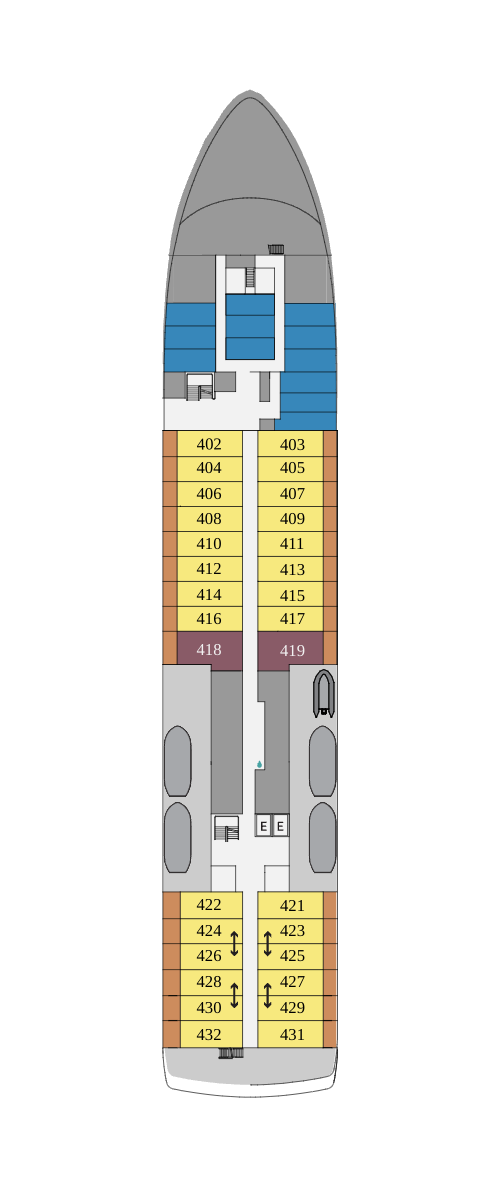
Deck 4 offers guests two categories of suites. The Balcony Suites feature one double or two single beds, and a 52 sq. ft. (4.8 sq. m) balcony, a refrigerator, safe, TV, and a bathroom with shower and heated floors. (Some Balcony Suites offer interconnecting rooms.) The larger Deluxe Balcony Suites feature one double or two single beds, a 70 sq. ft. (6.5 sq. m) balcony, refrigerator, safe, TV, and a bathroom with shower, bathtub and heated floors.
Cabin Options

Balcony Suite
Located on Decks 4 and 6, with approximately 226 sq. ft. (21 m2) of indoor living space, and a 52 sq. ft. (4.8 m2) balcony, this entry-level balcony suite is one of the largest available on a ship of this class. This suite is perfect for guests who are looking for both indoor and outdoor living spaces. There are four connecting suites in this category, making this an excellent option for families or groups wanting to stay connected to each other during their expedition.
Features: one double or two single beds, sitting area with sofa bed, private balcony, desk, refrigerator, TV, private bathroom with shower and heated floors.
Standard Amenities: hair dryer, bathrobe, slippers, shampoo, conditioner, shower gel, complimentary water bottle.

Deluxe Balcony Suite
Located on Decks 4 and 6, with approximately 299 sq. ft. (27.8 m2) of indoor living space, and a 70 sq. ft. (6.5 m2) balcony. This suite is perfect for guests wanting a larger living space, full bathroom, and a substantial balcony. Deluxe Balcony Suites are the first suite type to offer additional privacy in the bathroom with an enclosed toilet, a full bath and shower to make it easier for guests to get ready together in the morning.
Features: one double or two single beds, sitting area with sofa bed, private balcony, desk, refrigerator, TV, private bathroom with shower, bathtub and heated floors.
Standard Amenities: hair dryer, bathrobe, slippers, shampoo, conditioner, shower gel, complimentary water bottle.

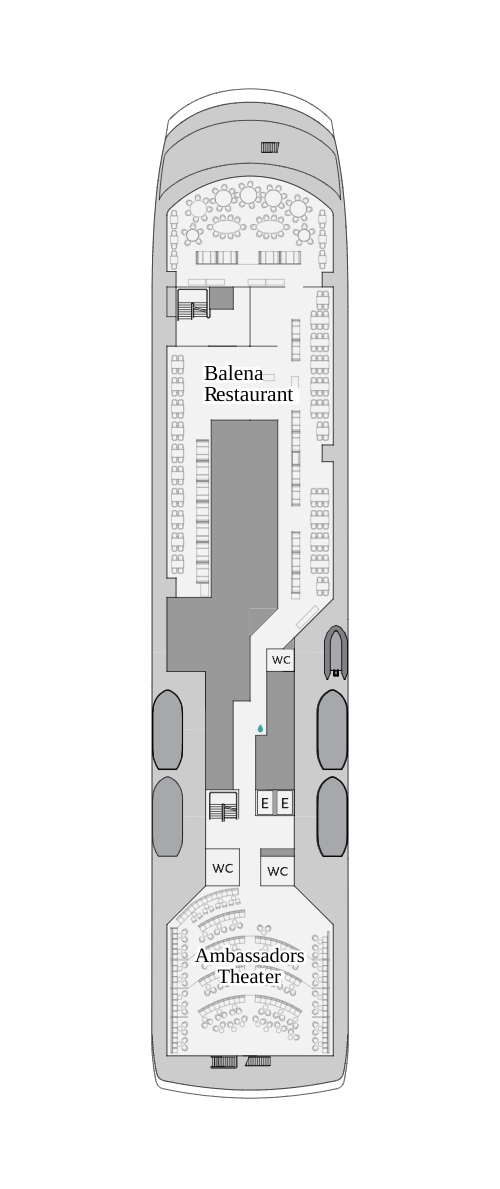
Deck 5 is home to Balena restaurant, featuring tables that accommodate 2 to 10 guests. Every seat in Ultramarine’s main restaurant offers views of the wraparound deck. At the opposite end of Deck 5 is the state-of-the-art Ambassador Theatre, where guests enjoy daily presentations and films on the high-definition LED wall screen. This space is large enough to accommodate all guests.
Public Spaces & Amenities

Ambassador Theater
A state-of-the-art, high-resolution LED screen wall in the main theater ensures high-definition viewing of presentations from your Expedition Team from any angle.

Balena Restaurant
Featuring table tops that accommodate 2 to 10, guests can enjoy a quiet dinner with a loved one or join a larger table of new friends. Guests will also enjoy views from every seat in addition to direct access to the wraparound deck.

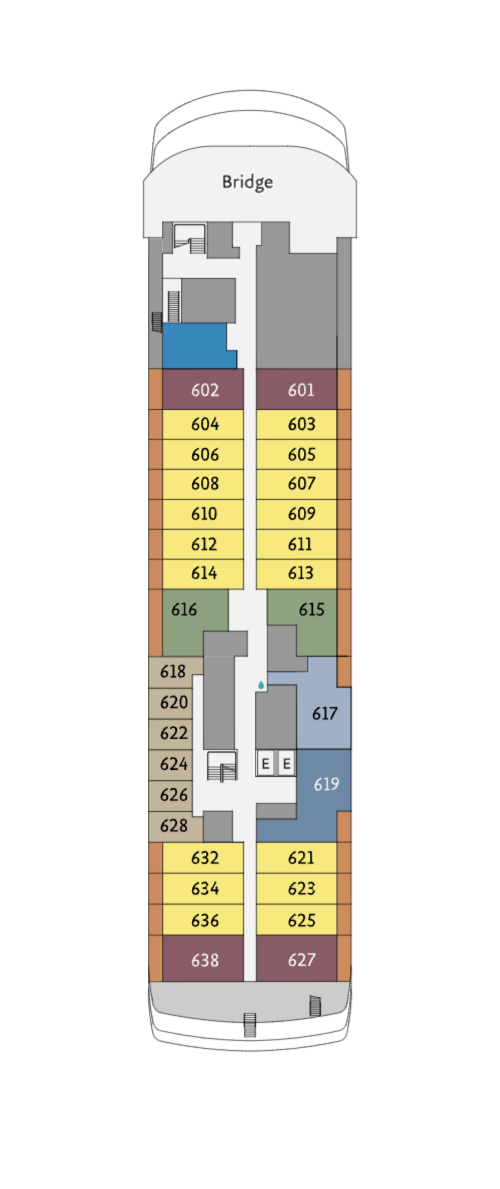
During your voyage you may be granted access to the Bridge to observe how the Captain and officers sail and navigate the ship. This is an excellent opportunity to learn how your vessel operates. Strict etiquette applies during Bridge visits which can be facilitated through the Expedition Leader. Also on Deck 6 is a selection of Deluxe Balcony Suites, Ultra Suite, Solo Panorama, Owner’s Suite and Terrace Suites.
Cabin Options

Solo Panorama
Located on Deck 6, and approximately 132 sq. ft. (12.3 m2). This suite is perfect for solo guests who appreciate privacy and want to wake up to sweeping views from the comfort of their bed. These are the only solo suites with floor-to-ceiling windows available onboard any ship in its class.
Features: single bed, floor-to-ceiling window, desk, refrigerator, TV, private bathroom with shower and heated floors.
Standard Amenities: hair dryer, bathrobe, slippers, shampoo, conditioner, shower gel, complimentary water bottle.

Balcony Suite
Located on Decks 4 and 6, with approximately 226 sq. ft. (21 m2) of indoor living space, and a 52 sq. ft. (4.8 m2) balcony, this entry-level balcony suite is one of the largest available on a ship of this class. This suite is perfect for guests who are looking for both indoor and outdoor living spaces. There are four connecting suites in this category, making this an excellent option for families or groups wanting to stay connected to each other during their expedition.
Features: one double or two single beds, sitting area with sofa bed, private balcony, desk, refrigerator, TV, private bathroom with shower and heated floors.
Standard Amenities: hair dryer, bathrobe, slippers, shampoo, conditioner, shower gel, complimentary water bottle.

Deluxe Balcony Suite
Located on Decks 4 and 6, with approximately 299 sq. ft. (27.8 m2) of indoor living space, and a 70 sq. ft. (6.5 m2) balcony. This suite is perfect for guests wanting a larger living space, full bathroom, and a substantial balcony. Deluxe Balcony Suites are the first suite type to offer additional privacy in the bathroom with an enclosed toilet, a full bath and shower to make it easier for guests to get ready together in the morning.
Features: one double or two single beds, sitting area with sofa bed, private balcony, desk, refrigerator, TV, private bathroom with shower, bathtub and heated floors.
Standard Amenities: hair dryer, bathrobe, slippers, shampoo, conditioner, shower gel, complimentary water bottle.

Terrace Suite
Located on Deck 6, with approximately 350 sq. ft. (32.5 m2) of indoor living space, and a 100 sq. ft. (9.3 m2) balcony. This suite is perfect for guests wanting generous interiors with a wide layout and the largest balconies on the ship. Centrally located on Deck 6, guests will enjoy minimal movement and motion from the comfort of these suites.
Features: one double or two single beds, sitting area with sofa bed, private extra-wide balcony, desk, refrigerator, TV, private bathroom with shower, bathtub and heated floors.
Standard Amenities: hair dryer, bathrobe, slippers, shampoo, conditioner, shower gel, complimentary water bottle.
Premium Amenities: upgraded bedding, in suite coffee.
Services: onboard WiFi credit*, included laundry**, in suite dining during scheduled meals.
*terms & conditions apply, WiFi may be limited in duration or data
**terms & conditions apply, limited number of laundry loads per voyage

Owner's Suite
Located on Deck 6, with approximately 446 sq. ft. (41.4 m2) of indoor living space and a 46.3 sq. ft. (4.3 m2) balcony. This suite is perfect for guests who want it all. A large, luxurious suite featuring a private bedroom, full bathroom, powder room, and two separate living spaces. This suite is perfect for families or couples who want all the comforts of home onboard the ship.
Features: one double or two single beds in a private bedroom with walk-in closet, sitting area with sofa bed and additional closet, private balcony, desk, refrigerator, TV, private bathroom with shower, bathtub and heated floors and separate powder room.
Standard Amenities: hair dryer, bathrobe, slippers, shampoo, conditioner, shower gel, complimentary water bottle.
Premium Amenities: upgraded bedding, in suite coffee, binoculars on loan.
Services: onboard WiFi credit*, included laundry**, in suite dining during scheduled meals, included spa package, upgraded hotel accommodation pre-/post-expedition where applicable, included arrival transfers where applicable.
*terms & conditions apply, WiFi may be limited in duration or data
**terms & conditions apply, limited number of laundry loads per voyage

Ultra Suite
Located on Deck 6, with approximately 563 sq. ft. (52.3m2) of interior living space, and a 46 sq. ft. (4.3 m2) balcony. This suite is perfect for guests who want to travel without compromise. Our largest and most luxurious suite features the most sleeping, entertainment and storage space onboard the ship. It is perfect for families or travelers who want all the comforts of home onboard the ship.
Features: one double or two single beds in a private bedroom with walk-in closet, sitting area with sofa bed and additional walk-in hallway closet, private balcony, desk, refrigerator, TV, private bathroom with shower, bathtub and heated floors and separate powder room.
Standard Amenities: hair dryer, bathrobe, slippers, shampoo, conditioner, shower gel, complimentary water bottle.
Premium Amenities: upgraded bedding, in suite coffee, binoculars on loan.
Services: onboard WiFi credit*, included laundry**, in suite dining during scheduled meals, included spa package, upgraded hotel accommodation pre-/post-expedition where applicable, included arrival transfers where applicable.
*terms & conditions apply, WiFi may be limited in duration or data
**terms & conditions apply, limited number of laundry loads per voyage
Public Spaces & Amenities

Bridge
During your voyage you may be given access to the Bridge, where you can observe how the Captain and officers sail and navigate the ship.

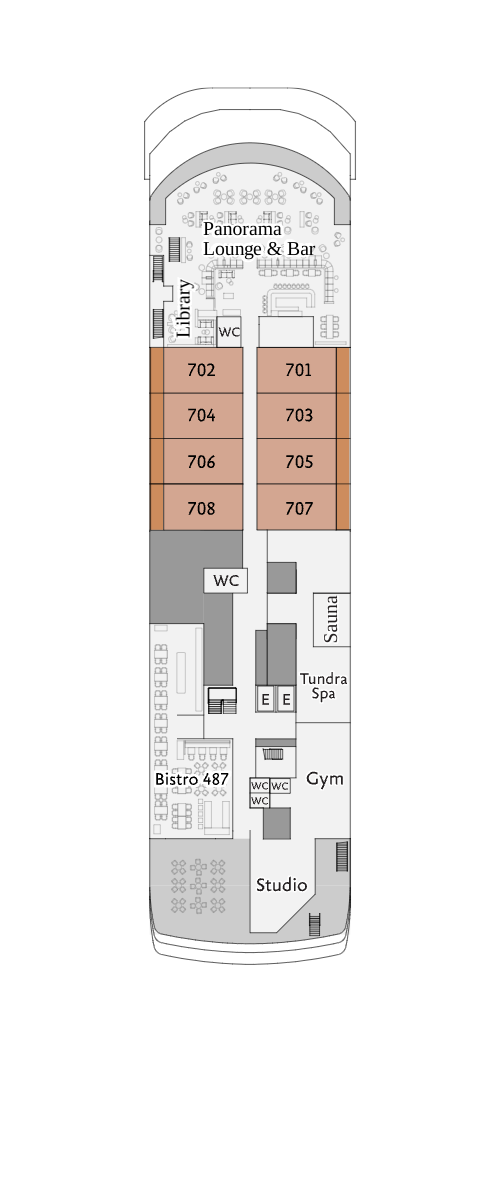
Guests can go to Deck 7 to visit Bistro 487, an alternative dining option to the larger Balena restaurant. Here, they’ll enjoy selections from the main menu, healthy eating options and light snacks, as well as an early riser’s breakfast, afternoon tea and late night snacks. Also on Deck 7 are the Sauna (with floor-to-ceiling windows), the Library, Tundra Spa, a gym with the latest fitness equipment, and studio space for informal yoga.
Cabin Options

Penthouse Suite
The only suite category to be located on Deck 7, with approximately 369 sq. ft. (34.3 m2) of indoor living space, and a 67 sq. ft. (6.2 m2) balcony. This suite is perfect for guests wanting to wake up to unobstructed polar views from the warmth and comfort of their bed onboard the ship. These suites offer the best of everything—views, spacious interiors, full bathrooms and generous balcony sizes—as well as easy access to the wellness centre.
Features: one double or two single beds, sitting area with sofa bed, private balcony, desk, refrigerator, TV, private bathroom with shower, bathtub and heated floors.
Standard Amenities: hair dryer, bathrobe, slippers, shampoo, conditioner, shower gel, complimentary water bottle.
Premium Amenities: upgraded bedding, in suite coffee.
Services: onboard WiFi credit*, included laundry**, in suite dining during scheduled meals.
*terms & conditions apply, WiFi may be limited in duration or data
**terms & conditions apply, limited number of laundry loads per voyage
Public Spaces & Amenities

Bistro 487
Guests can enjoy a meal in the Bistro which offers an indoor/outdoor dining experience. Perfect for enjoying the polar landscapes.

Tundra Spa
Offering a variety of treatments exclusively crafted for our guests, the spa and adjacent steam room allow passengers; to fully relax and unwind before their next off-ship adventure.

Tundra Sauna
Perfectly juxtaposed luxury: guests can rest and relax in the comfort and warmth of the sauna while enjoying the spectacular views outside.

Fitness Center
In the fully-equipped fitness center, featuring a separate yoga space with views to the outside.

Panorama Lounge and Bar
Enclosed in glass and featuring unobstructed views, the Panorama Lounge and Bar allows guests to relax indoors while staying connected to the awe-inspiring landscapes drifting by. It serves as a cozy gathering point where guests can sip a glass of wine, engage in great conversation, indulge in a board game, or socialize at the bar—and, later in the evening, bust a move on the dance floor.


Ultramarine’s two twin-engine H145 helicopters enable guests to enjoy the largest selection of off-ship adventures, all of which start at the two helidecks. It’s here on Deck 8 that guests will safely board the two helicopters to experience more unique aerial perspectives and heli-supported activities than are possible on any other ship in the industry.
Your Life Onboard






Enjoy panoramic views while you mingle in our comfy lounges, or head outside and chat with fellow adventurers on the wraparound deck. Our social spaces foster connections & shared experiences.

Engage with world-class experts in our auditorium. Presentations cover wildlife, history, marine biology, ecology, & geology, to enhance your polar knowledge & excitement for exploration.

Enjoy onboard amenities, attend lectures, or watch for wildlife from our observation decks. Sea days offer a perfect blend of education, relaxation, and anticipation.

Find tranquility in our well-stocked library, perfect for reading or quiet contemplation. The glass-domed Observation Lounge offers a peaceful retreat to reflect & enjoy awe-inspiring polar views.

Prepare for off-ship excursions in our spacious mudroom. Kayak, paddleboard, or take a plunge in polar waters. Stay active onboard with our gym, outdoor track, and pool facilities.

What’s Included
Specialist Expedition Leaders
Our team is comprised of the most professional and passionate Expedition Leaders in the world, who bring a wide range of experience and expertise to every adventure.
Immersive Off-ship Activities
Itineraries are packed with adventure options designed to immerses travelers in the polar wilderness, enabling them to connect with the natural wonders of their surroundings.
On-Ship Experiences & Facilities
Designed for comfort and adventure, each ship accommodates no more than 200 guests. Facilities include comfortable cabins, exceptional dining options, wellness treatments, and breathtaking panoramic views of the polar landscape.
Food & Beverages
Premium dining, with a wide selection of options that accommodate a variety of dietary preferences.
Quark Expedition Perks
Complementary Wi-Fi, alcohol on all voyages, and the Official Quark Expeditions parka to take home.
Transfers
Select voyages include essential transportation and accommodation arrangements for guests, ensuring seamless travel to and from the expedition starting point.
International airfare & visa expenses, travel insurance, mandatory expedition gear, on-ship expenses, adventure options and trip extensions are not included.
Included Activities
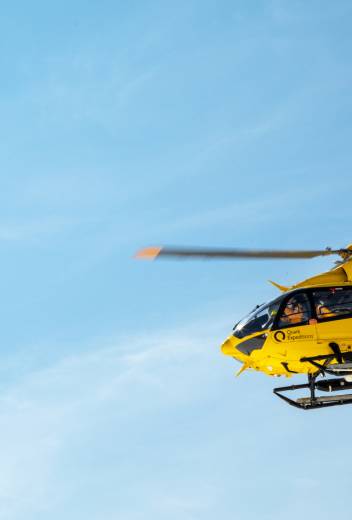
Flightseeing

Zodiac Cruising

Hiking

Polar Plunge

Presentations

Photography
Upgrade Your Expedition
Find out what add-on options are available for your expedition.
Adventure Options
These can be booked in advance at an extra cost. Activities vary by itinerary, destination and are weather permitting.
Trip Extensions

Calgary, Canada
Before heading to the Arctic, take a few days in Calgary.
Possible Excursions
When traveling in extremely remote regions, your Expedition Team must consider the sea, ice and weather to guide the route and itinerary details. The following sites are a sample of what you may experience on your expedition, whether by ship, Zodiac cruise, helicopter, or shore landing.
Situated on Baffin Island’s most northerly shore is Admiralty Inlet, whose steep coastline soars 1,500 feet (460 meters) above sea level. Just off the inlet’s northeastern shore lies Arctic Bay, an Inuit community we partner with to arrange authentic experiences that highlight the best this area has to offer. Narwhals and polar bears are known to frequent the fjord.
Arctic BayThis picturesque and remote community maintains strong ties to the land and sea, as its Inuit inhabitants have lived as nomadic hunters in this region for almost 5,000 years. The protective high hills and sheltered shores of this hamlet make for an ideal nesting habitat for various Arctic birds, including thick-billed murres, kittiwakes, ivory gulls and Ross’s gulls. Seals, narwhals and bowhead whales call the waters here home.
Axel Heiberg IslandMost famous for its mummified forest dating back over 30 million years, the island is home to several bird species, including arctic terns, geese, jaegers, snow buntings and ptarmigans. It’s named after Axel Heiberg, the sponsor of the 1897–1902 Norwegian expedition led by Otto Sverdrup to explore and name unchartered areas of the Arctic. Today, the island is the location of one of the longest-operating seasonal field research facilities (est. 1960) in the High Arctic. If we’re able to make landing here, we will take precautions to preserve this important geological site.
Beechey IslandNamed after Frederick William Beechey, an explorer with the Royal Navy, this is one of Canada’s most important Arctic sites and has been deemed a Canadian National Historic Site. During the Franklin expedition of 1845–46, two of Franklin’s ships, HMS Erebus and HMS Terror, anchored here with perilous results. Three of Franklin’s crew died here and are buried at marked gravesites.
Coburg IslandA well-known nesting ground, Coburg Island is a wildlife reserve with a diverse avian community. Greater snow geese, snowy owls, peregrine falcons and gyrfalcons thrive in the protected environment at certain times of the year.
Croker BayOn the south coast of Devon Island is Croker Bay. A glacier here actively calves off chunks of ice, creating a birthplace for icebergs. The bay was a popular stop during the 1800s, when a path to the Pacific (the Northwest Passage) was at the forefront of Arctic exploration.
Devon IslandThis is the largest uninhabited island in the world. Marking the northern side of Lancaster Sound, this desert island is so cold and dry that NASA and other organizations conduct research here for future missions to Mars. The Inuktitut name, Tallurutit means “tatoos on the chin” referring to the similarity of the geological features of the area to an Inuit woman’s traditional chin tattoos.
Dundas HarbourLocated on Devon Island, there are the remains of a Royal Canadian Mounted Police post, dating back to 1924. The RCMP cemetery is tended annually by a contingent of Mounties, who arrive especially for that purpose. Other evidence of human habitation found nearby is centuries older.
Ellesmere IslandThe most northerly point of land in Canada, this island at the top of the world features dramatic glacier-capped peaks that soar over 8,200 feet (2,500 meters). It is the third-largest island in the country and the 10th largest in the world. Those fortunate to visit Ellesmere will have achieved one of the most elusive landmarks in all of polar exploration.
Fort RossIn 1937, the Hudson’s Bay Company established a trading post, named Fort Ross, on the coast of Somerset Island. Due to the harsh conditions and isolation of the post, it was closed in 1948. The store and manager’s house still stand.
Grise FiordThe Inuktitut name for this Ellesmere Island hamlet means “place that never thaws.” From April to August, the residents of Canada’s most northerly Inuit community experience continuous daylight.
Hell GateKnown as the gateway to the mysterious Norwegian Bay, this narrow waterway runs alongside North Kent Island and sits between two of Canada’s most beautiful islands: Ellesmere Island and Devon Island. Transiting the channel is a rite of passage for any High Arctic explorer, as passing through it takes you to one of the most spectacular yet seldom-visited parts of our planet, Ellesmere Island. A natural convergence, channeling currents, drifting ice and marine life between its shores, Hell Gate supports a higher concentration of wildlife, including polar bears and northern fulmars, compared with the surrounding areas.
Prince Leopold IslandImpressive, vertical cliffs surround part of this small island. This creates an ideal environment for nesting seabirds, and they nest here in vast numbers—more than 300,000 strong! Thick-billed murres, black guillemots and northern fulmars are most commonly seen here.
ResoluteOne of Canada’s most northern settlements, Resolute was formed by forceful relocation of Inuit from northern Quebec by the Canadian government in 1953, during the Cold War. Today, it’s also a jumping off point for much high Arctic research. It has everything from a grocery store and cable TV to a school and a couple of hotels. About 200 people live in Resolute throughout the year, where hunting and logistical support to research, mining and tourism contribute to the community’s economy.
Winter Harbour, Melville IslandWinter Harbour is the overwintering site of legendary explorer Sir William Parry’s famous 1819–20 expedition to find the Northwest Passage. The first recorded voyage to this region, it predates the later exploration of Sir John Franklin and others by over 20 years! The site is home to a large sandstone rock known as Parry’s Rock. Designated a National Historic Site of Canada in 1930, this natural monument bears an inscription by the ship’s surgeon of the expedition’s vessels and their captains, as well as a plaque marking when Canada took possession of the Arctic Archipelago.
Departure Dates & Cabins
Know Before You Go
For your personal safety—and to ensure you get the most enjoyment out of your polar adventure—please assess your mobility and medical requirements before booking. It is essential that guests have a high level of mobility to get in and out of Zodiac boats, and for off-ship activities such as hiking on uneven terrain. Our destinations are remote. Apart from our basic ship infirmary, it could take up to 72 hours to reach adequate medical facilities. For more details to help you assess your mobility and medical requirements before booking your voyage, please review Health & Safety.
Some of our expeditions have included transfers and these will be detailed in your Invoice and Trip Brochure.
Please note that if you have an airport transfer included in your trip, it is only available if you arrive on Day 1 of the itinerary. Please ensure your flight information on your Passenger Forms is up to date so our ground crew know when to expect you. There will be someone with a sign in Arrivals waiting for you. Please look for them and they will direct you to our group shuttle.
If you do not have included transfers, or you are arriving before Day 1, you will need to make your own way to the hotel. Most airports we travel in and out of have good taxi ranks in the Arrivals area, or you can often prebook a transfer online.
Packing is an exciting part of the trip for many of us. You will find a handy packing list towards the end of your Trip Brochure. You will have received a copy of this when you first booked. We also have two excellent videos, which you can check out here: What to Pack
Our Protection Promise allows you to make a purchase decision that will leave you worry-free in the event your plans change down the road. Please review details for each term in our Quark Expeditions Protection Promise.
Whether you are thinking of an expedition, or you’ve booked the trip of a lifetime with Quark Expeditions, review all our FAQs for comprehensive tips to help you prepare for the Polar Regions and how to make the most out of your voyage with the most experienced expedition team in the industry. If your specific question isn’t covered below, please reach out to your Polar Travel Advisor or helpful Client Experience Team at guest@quarkexpeditions.com.







